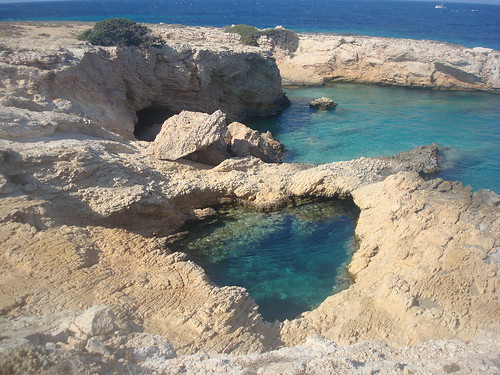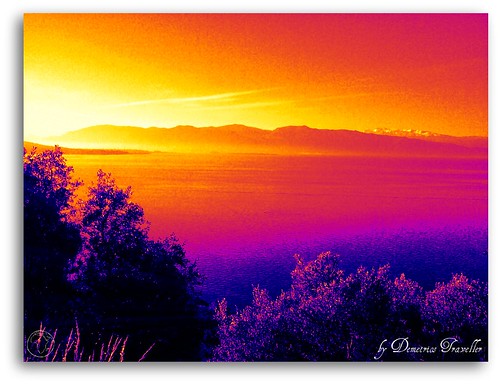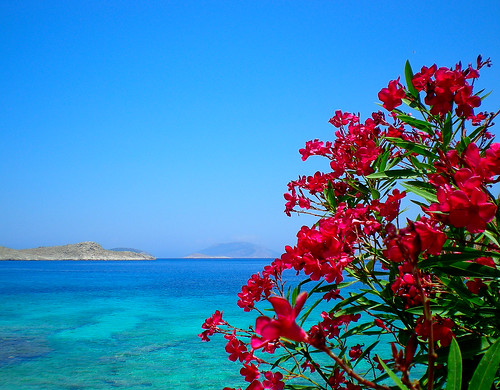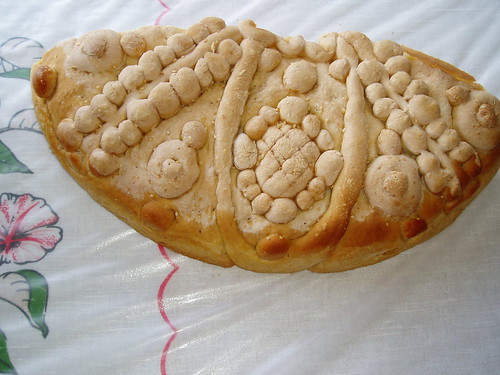Pano Koufonisi is the smallest and most densely populated island of the Cycladic island group. It has an area of 3.5 km² and 366 residents.
The main occupation of the locals is fishing and, in recent years, tourism. Compared to its population, it has one of the biggest fishing fleets in Greece.
The white windmill on the east side of the port welcomes visitors when they arrive on the island. The settlement of Chora on the southwest coast of Koufonisi is a characteristic example of Cycladic architecture.
Its sandy beaches make up the island's picture. Koufonisi has only been developed the last ten years, as far as tourism is concerned, so the natural beauty and its traditional colour has remained unfaded.
Wednesday, June 26, 2013
A Natural Swimming Pool @ Pano #Koufonisi #Cyclades #Greece
Wednesday, June 27, 2012
The Impact Of Social Media On Travel And Tourism [INFOGRAPHIC]
Social media has made a huge impact on essentially every major industry across the world, and the business of travel and hospitality has reaped the rewards perhaps as well as any other commercial venture. Travel and tourism depends heavily on the use of word-of-mouth to spread opinions and recommendations, and social platforms such as Twitter and Facebook allow customers to easily share tips and suggestions, which can be enormously valuable when positive. Some 92 percent of consumers said that they trusted earned media, which includes recommendations from friends and family members, more than any other form of advertising.
Moreover, a recent study showed that more than half (52 percent) of respondents changed their travel plans after researching their trip using social media. A heady 85 percent of travelers use their smartphones whilst abroad, and 52 percent of Facebook users said that their friends’ holiday photos had inspired their vacation choice.
This infographic from Four Pillars takes a closer look at the impact of social media on the travel and hospitality industry.
Thursday, May 31, 2012
still sunny in our land
still sunny in our land #Pelasgia central #Greece #travel #ttot #travelling2GR #visitGreece
PHOTO via: brexians ... http://www.flickr.com/photos/brexians/6515549373/
PHOTO via: brexians ... http://www.flickr.com/photos/brexians/6515549373/
Monday, May 28, 2012
Ios island ... church @ daylight
a superb #photo from #Ios #Cyclades #Greece #travel #ttot #travelling2GR #visitGReece
PHOTO via: Christos Loufopoulos http://www.flickr.com/photos/ophilos/7278508502/
Ios (Greek: Ίος, locally Νιός - Nios) is a Greek island in the Cyclades group in the Aegean Sea. Ios is a hilly island with cliffs down to the sea on most sides, situated halfway betweenNaxos and Santorini. It is about 18 km (11 mi) long and 10 km (6 mi) wide, with an area of about 109 km² (42 mi²). Population was 1,838 in 2001 (down from 3,500 in the 19th century). Ios is part of the Thira regional unit. Ios was the setting for the movie Ginger and Cinnamon (Dillo con parole mie). Also, scenes from the film Big Blue (Le Grand Bleu) were shot in Manganari.
The Port of Ios is at the head of the Ormos harbor in the northwest. From there the bus or a 15-minute walk up the steep donkey path takes you to the village, known as Chora. Chora is a white and very picturesque cycladic village, full of stairs and narrow paths, that makes it inaccessible for cars of any kind. Today, the main path through this village is completely taken over by tourism in terms of restaurants, boutiques, bars and discothèques. Apart from the port and the village of Chora, Ios has only a few small settlements, just a group of spread out houses in the background of major beaches (Theodoti, Kalamos, Maganari). Since the 1990s, the island mayor Pousseos has worked on Ios' development towards attracting different types of tourists. With the help of European Community funds some roads have been built, all of them paved, and a scenic amphitheater has been created by the German architect Peter Haupt (who died in 2003) at the top of the village hill. Unfortunately, cultural events rarely take place up there.
PHOTO via: Christos Loufopoulos http://www.flickr.com/photos/ophilos/7278508502/
Ios (Greek: Ίος, locally Νιός - Nios) is a Greek island in the Cyclades group in the Aegean Sea. Ios is a hilly island with cliffs down to the sea on most sides, situated halfway betweenNaxos and Santorini. It is about 18 km (11 mi) long and 10 km (6 mi) wide, with an area of about 109 km² (42 mi²). Population was 1,838 in 2001 (down from 3,500 in the 19th century). Ios is part of the Thira regional unit. Ios was the setting for the movie Ginger and Cinnamon (Dillo con parole mie). Also, scenes from the film Big Blue (Le Grand Bleu) were shot in Manganari.
The Port of Ios is at the head of the Ormos harbor in the northwest. From there the bus or a 15-minute walk up the steep donkey path takes you to the village, known as Chora. Chora is a white and very picturesque cycladic village, full of stairs and narrow paths, that makes it inaccessible for cars of any kind. Today, the main path through this village is completely taken over by tourism in terms of restaurants, boutiques, bars and discothèques. Apart from the port and the village of Chora, Ios has only a few small settlements, just a group of spread out houses in the background of major beaches (Theodoti, Kalamos, Maganari). Since the 1990s, the island mayor Pousseos has worked on Ios' development towards attracting different types of tourists. With the help of European Community funds some roads have been built, all of them paved, and a scenic amphitheater has been created by the German architect Peter Haupt (who died in 2003) at the top of the village hill. Unfortunately, cultural events rarely take place up there.
Excavations on Skarkos hill unearthed a prehistoric settlement, proving that Ios has been inhabited since the early Cycladic period. The architecture at Skarkos is preserved in places up to a height of almost three meters, with most of the buildings evidently having two storeys, stone-paved floors and a sewage system. Numerous well-preserved pottery, tools and utensils made of metal, stone and bone were also discovered. Unfortunately, the Skarkos site remains largely unpublished. In 2008, Ios was among six European locations (out of 109 candidates) awarded the European Union Cultural Heritage prize for its exceptional conservation efforts at the archaeological site of Skarkos.
During later times, Ios made rather few marks in history. According to ancient tradition, Homer's mother was from Ios, and he himself was buried there - and indeed the locals will show visitors the site of the ancient town of Plakotos at the northernmost end of the island, where the rocky entrance to a tomb may be seen. There is no physical evidence connecting this with Homer however. There are signs of Mycenaean settlement. The north end of Ios has a ruined Venetian castle from the 15th century. The island is said to have 365 churches and chapels, like the days of the year.
Ios attracts a large number of young tourists, many of whom used to sleep on their sleeping bags during the 1970s on the popular beach of Mylopotas after partying through the night. Today Mylopotas beach has been developed to an equivalent mass package tourism resort like Platys Gialos and Paradise Beach of Mykonos.
From Wikipedia, the free encyclopedia
Tuesday, May 22, 2012
Lalaria beach Skiathos
Lalaria Beach #Skiathos island #Greece #travel #ttot #travelling2GR #visitGReece
PHOTO via: Konstantinos Vainas http://www.flickr.com/photos/vainas/1142244759/
Skiathos (Greek: Σκιάθος, pronounced [sciˈaθos]; Latin forms: Sciathos and Sciathus) is a small Greek island in the northwest Aegean Sea. Skiathos is the westernmost island in the Northern Sporades group, east of the Pelion peninsula in Magnesia on the mainland, and west of the island of Skopelos.
PHOTO via: Konstantinos Vainas http://www.flickr.com/photos/vainas/1142244759/
Skiathos (Greek: Σκιάθος, pronounced [sciˈaθos]; Latin forms: Sciathos and Sciathus) is a small Greek island in the northwest Aegean Sea. Skiathos is the westernmost island in the Northern Sporades group, east of the Pelion peninsula in Magnesia on the mainland, and west of the island of Skopelos.
In Ancient times, the island played a minor role during the Persian Wars. In 480 BC, the fleet of the Persian King Xerxes was hit by a storm and was badly damaged on the rocks of the Skiathos coast. Following this the Greek fleet blockaded the adjacent seas to prevent naval invasion and provisions for the enemy of 300 Spartans who stood heroically at Thermopylaepass. The Persian fleet was defeated there at Artemisium and finally destroyed at the Battle of Salamis a year later. Skiathos remained in the Delian League until it lost its independence. The city was destroyed by Philip V of Macedon in 200 BC.
In 1207 the Gyzi brothers captured the island and built the Bourtzi, a small Venetian-styled fortress similar to the Bourtzi in Nafplio, on an islet just out of Skiathos Town, to protect the capital from the pirates. But the Bourtzi was ineffective in protecting the population and in the mid-14th century the inhabitants moved the capital from the ancient site that lay where modern Skiathos Town is to Kastro (the Greek word for castle), located on a high rock, overlooking a steep cliff above the sea at the northernmost part of the island.
In 1704 monks from Athos built the Evangelistria monastery which played a part on the Greek War of Independence as a hide-out for Greek rebels. The first flag of Greece was created and hoisted in the Evangelistria monastery in Skiathos in 1807. Several prominent military leaders (including Theodoros Kolokotronis and Andreas Miaoulis) had gathered there for consultation concerning an uprising, and they were sworn to this flag by the local bishop.
The film Mamma Mia was partially filmed on Skiathos and nearby island Skopelos. This has increased its popularity as a tourist destination since the release of the successful movie.After the War of Independence and demise of piracy in the Aegean, Kastro became less important as a strategic location. In 1830s, the island's capital was moved to the original site — where it still remains. Today, ruins of Kastro are one of tourist attractions. During the 19th century Skiathos became an important shipbuilding centre in the Aegean due to the abundance of pine forests on the island. The pine woods of the island were then almost obliterated. This was brought to a halt though, due to the emergence of steamboats. A small shipwright remains north of Skiathos Town, which still builds traditional Greek caiques.
Hollywood actor Richard Romanus moved to the island in 2001 with his wife. He has written a book about his move to the island called "Act III".
Sunday, May 13, 2012
Greek Beauties ...
Χρόνια Πολλά σ' όλες τις μανάδες του κόσμου !
#Greek Beauties ... #Chalki , #Greece
PHOTO via: Anna http://www.flickr.com/photos/9426538@N07/3904663876/
#Greek Beauties ... #Chalki , #Greece
PHOTO via: Anna http://www.flickr.com/photos/9426538@N07/3904663876/
Labels:
Chalki,
Dodecanese,
environment,
environmental,
Greece,
Γιορτή Μητέρας,
περιβάλλον,
τουρισμός
Location:
Χάλκη 85100, Ελλάς
Friday, May 11, 2012
Traditional wedding bread, Thermo Nafpaktias, Greece.
Traditional #wedding bread, #gastronomy #Thermo #Aetolia-Acarnania #Greece #travel #ttot #travelling2GR #visitGReece
PHOTO via: Kakia Chatsiou http://www.flickr.com/photos/50568843@N00/2370754633/
Thermo (Greek: Θέρμο, before 1915: Κεφαλόβρυσον - Kefalovryson) is a town and a municipality in Aetolia-Acarnania, Greece. It is located in the southeastern part of the regional unit, largely between Lake Trichonida (the largest natural lake in Greece) and the southern border of Evrytania. It has a land area of 333.701 km² and a 2001 census population of 9,299 inhabitants. Its municipal seat is the town of Thérmo (pop. 1,898). Its largest other towns are Análipsis (pop. 669), Petrochóri (527), Sitarálona (390), Palaiómylos (373), Myrtéa (355), and Amvrakía (349). Thermo took its name from the ancient city Thermos, that was located near the present town.
PHOTO via: Kakia Chatsiou http://www.flickr.com/photos/50568843@N00/2370754633/
Thermo (Greek: Θέρμο, before 1915: Κεφαλόβρυσον - Kefalovryson) is a town and a municipality in Aetolia-Acarnania, Greece. It is located in the southeastern part of the regional unit, largely between Lake Trichonida (the largest natural lake in Greece) and the southern border of Evrytania. It has a land area of 333.701 km² and a 2001 census population of 9,299 inhabitants. Its municipal seat is the town of Thérmo (pop. 1,898). Its largest other towns are Análipsis (pop. 669), Petrochóri (527), Sitarálona (390), Palaiómylos (373), Myrtéa (355), and Amvrakía (349). Thermo took its name from the ancient city Thermos, that was located near the present town.
Subscribe to:
Posts (Atom)







